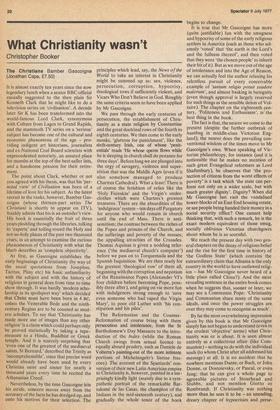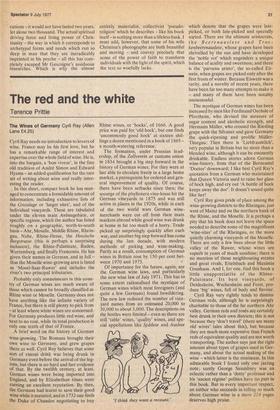What Christianity wasn't
Christopher Booker
The Christians Bamber Gascoigne (Jonathan Cape, £7.50) It is almost exactly ten years since the now legendary lunch when a senior BBC official casually suggested to the then plain Sir Kenneth Clark that he might like to do a television series on 'civilisation'. A decade later Sir K has been transformed into the world-famous Lord Clark, synonymous with Culture from Lagos to Grand Rapids, and the mammoth TV series on a 'serious' subject has become one of the cultural and economic phenomena of the age — providing indigent art historians, journalists and ex-National Coal Board scientists with unprecedented notoriety, an assured place for months at the top of the best-seller lists, and a handsome pension for their retirement.
The point about Clark, whether or not you agreed with his thesis, was that his 'personal view' of Civilisation was born of a lifetime of love for his subject. As the latest recruit to the ranks, however, Bamber Gascoigne (whose thirteen-part series The ChristiartS is shortly to appear on ITV), frankly admits that his is an outsider's view. His book is essentially the fruit of three years plodding through the libraries, talking to 'experts' and toiling round the Holy and not-so-holy places of the past two thousand years, in an attempt to examine the curious phenomenon of Christianity with what the blurb describes as 'complete objectivity'.
At first, as Gascoigne establishes the early beginnings of Christianity (by way of the usual quotations from Josephus, Tacitus, Pliny etc) his basic unfamiliarity with the subject and with the history of religions in general does from time to time show through. It was hardly 'modern scho larship in its spoilsport way' which decided that Christ must have been born in 4 tic, unless the Venerable Bede and the ninthcentury Regino are to be counted as mod ern scholars. To say that 'Christianity has made more use of images than any other religion' is a claim which could perhaps only be proved statistically by taking a tapemeasure to a Hindu, Buddhist or Greek temple. And it is scarcely surprising that 'even one of the greatest of the mediaeval saints, St Bernard,' described the Trinity as 'incomprehensible', since that precise word would already have been used by every Christian saint and sinner for nearly a thousand years every time he recited the Athanasian Creed.
Nevertheless, by the time Gascoigne hits his stride, concern moves away from the accuracy of the facts he has dredged up, and onto his motives for their selection. The
principles which lead, say, the News of the World to take an interest in Christianity might be summed up as: sex, violence, persecution, corruption, hypocrisy, theological rows if sufficiently violent, and Vicars Who Don't Believe in God. Roughly the same criteria seem to have been applied by Mr Gascoigne.
We pass through the early centuries of persecution, the establishment of Christianity as a state religion by Constantine and the great doctrinal rows of the fourth to eighth centuries. We then come to the early monks, 'gluttons for punishment', like the sixth-century Irish, one of whose 'penitentials' reads 'He whose sperm flows while he is sleeping in church shall do penance for three days'. Before long we are plunged into the orgy of savagery, violence and superstition that was the Middle Ages (even if it also somehow managed to produce Chartres Cathedral). What a feast! There is of course the fetishism of relics like the 'Holy Foreskin' and the Virgin's underclothes which were Chartres's greatest treasures. There are the absurdities of the 'indulgence' system — ten days off Purgatory for anyone who would remain in church until the end of Mass. There is antiSemitism; the contrast between the riches of the Popes and princes of the Church, and the sufferings and poverty of the masses; the appalling atrocities of the Crusades. Thomas Aquinas is given a nodding reference ('the mediaeval church's computer') before we pass on to Torquemada and the Spanish Inquisition. We are then ready for the greatest 'theological row' of them all, beginning with the corruption and nepotism of the Renaissance Popes (Alexander VI's four children before becoming Pope, possibly three after), and going on via more fun with indulgences strong enough to 'save even someone who had raped the Virgin Mary', to poor old Luther with 'his constipation and his piles'.
The Reformation and the CounterReformation of course bring with them persecution and intolerance, from the St Bartholomew's Day Massacre to the introduction of the Index. (while the Roman Church swings from sexual licence to equally absurd prudery, such as Daniele de Volterra's painting-out of the more intimate portions of Michelangelo's Sistine frescoes). The account of the Spaniards' conversion of their new Latin American empire to Christianity is, however, painted in a surprisingly kindly light (mainly due to a sympathetic portrait of the remarkable Bartolome de las Casas, the champion of the Indians in the mid-sixteenth century), and gradually the whole tenor of the book
begins to change.
It is true that Mr Gascoigne has more (quite justifiable) fun with the smugness and hypocrisy of some of the early religious settlers in America (such as those who solemnly 'voted' that 'the earth is the Lord's and the fullness thereof', and then voted that they were 'the chosen people' to inherit their bit of it). But as we move out of the age of intolerance and into the Age of Reason, we can actually feel the author relaxing his relentless pursuit of every conceivable example of 'tantum religio potuit suadere malorue, and almost basking in benignity (even though approval is largely reserved for such things as the sensible deism of Voltaire). The chapter on the eighteenth century, 'Politeness and Enthusiasm', is) the best thing in the book.
The fact is that, the nearer we come to the present (despite the further outbreak of humbug in middle-class Victorian England), the nearer does the prevailing conventional wisdom of the times move to Mr Gascoigne's own. When speaking of Victorian philanthropy, for instance (and it is noticeable that he makes no mention of such great Evangelical reformers as Lord Shaftesbury), he observes that 'the protection of citizens from the worst effects of poverty' is a task which 'the state can perform not only on a wider scale, but with much greater dignity'. Dignity? When did Mr Gascoigne last visit the vandalised tower-blocks of an East End housing estate, or see people being handed their money in a social security office? One cannot help thinking that, with such a remark, he is the exact modern equivalent of those smug, socially oblivious Victorian churchgoers about whom he is so scornful.
We reach the present day with two general chapters on the decay of religious belief and the rise for the first time in history of 'the Godless State' (which contains the extraordinary claim that Albania is the only country in the world to have outlawed religion — has Mr Gascoigne never heard of a little place called China?). And the most revealing sentence in the entire book comes when he suggests that, sooner or later, we may see a Communist Pope: 'Christianity and Communism share many of the same ideals, and once the power struggles are over they may come to recognise as much'.
By far the most overwhelming impression given by this book is that Mr Gascoigne simply has not begun to understand (even in the crudest 'objective' terms) what Christianity was or is about. It is seen almost entirely as a collectivist affair (like Communism) —nothing to do with the individual souls (to whom Christ after all addressed his message) at all. It is no accident that he nowhere mentions Dante, or Bach, or John Donne, or Dostoievsky, or Pascal, or even Jung; that he can give a whole page to agreeable pictures of Stourhead and Stubbs, and not mention Giotto or Rembrandt. If Christianity was nothing more than he sees it to be — an unending, dreary chapter of hypocrisies and perse cutions —it would not have lasted two years, let alone two thousand. The actual spiritual driving force and living power of Christianity — the way in which it corresponds to archetypal forms and needs which run so deep in man that they are ineradicably imprinted in his psyche — all this has'completely escaped Mr Gascoigne's assiduous researches. Which is why the almost entirely materialist, collectivist 'pseudoreligion' which he describes — like his book itself —is nothjng more than a lifeless husk. I must add, however, that some of his wife Christina's photographs are both beautiful and moving — and convey precisely that sense of the power of faith to transform individuals with the light of the spirit, which the text so woefully lacks.



































 Previous page
Previous page